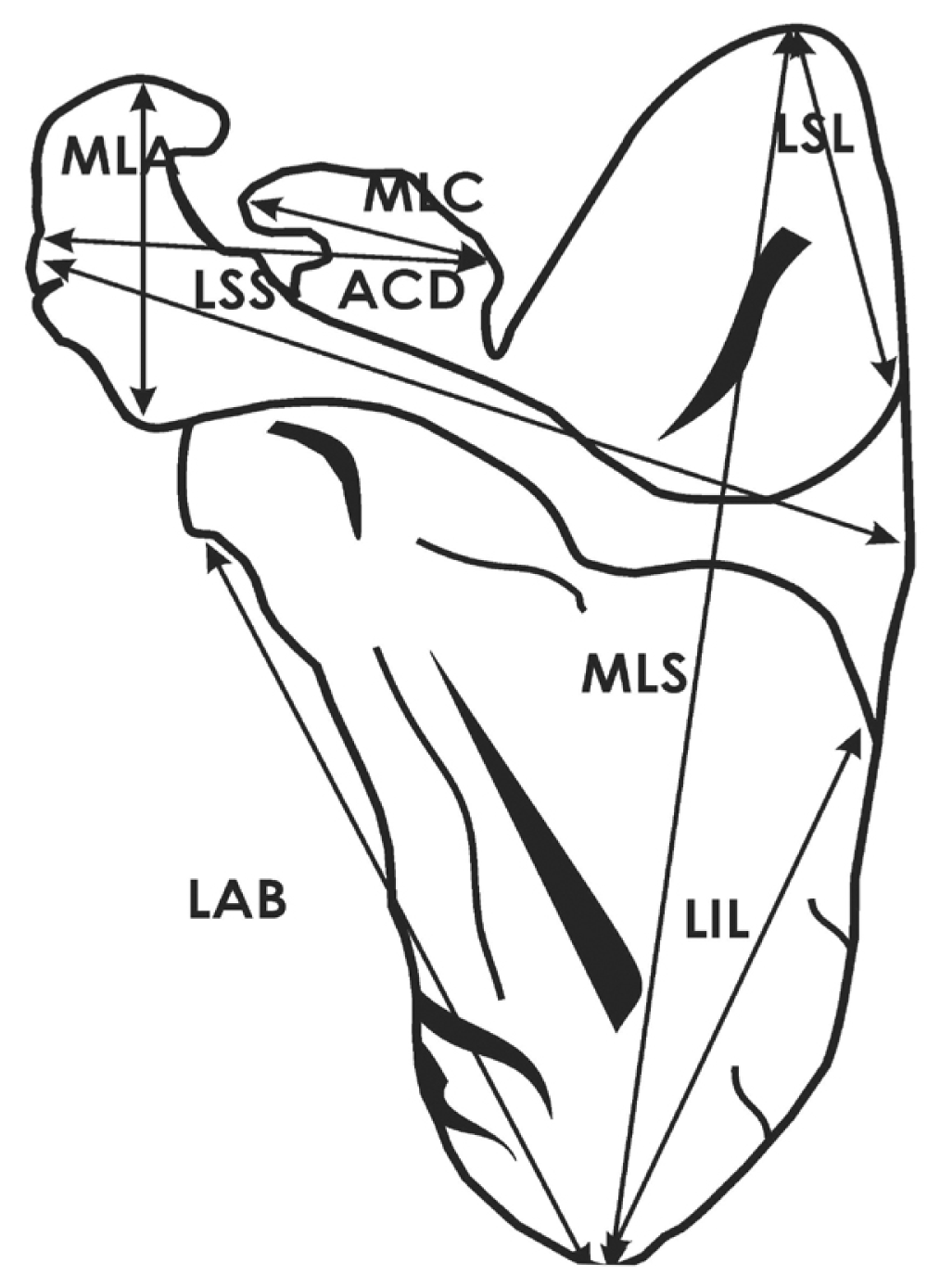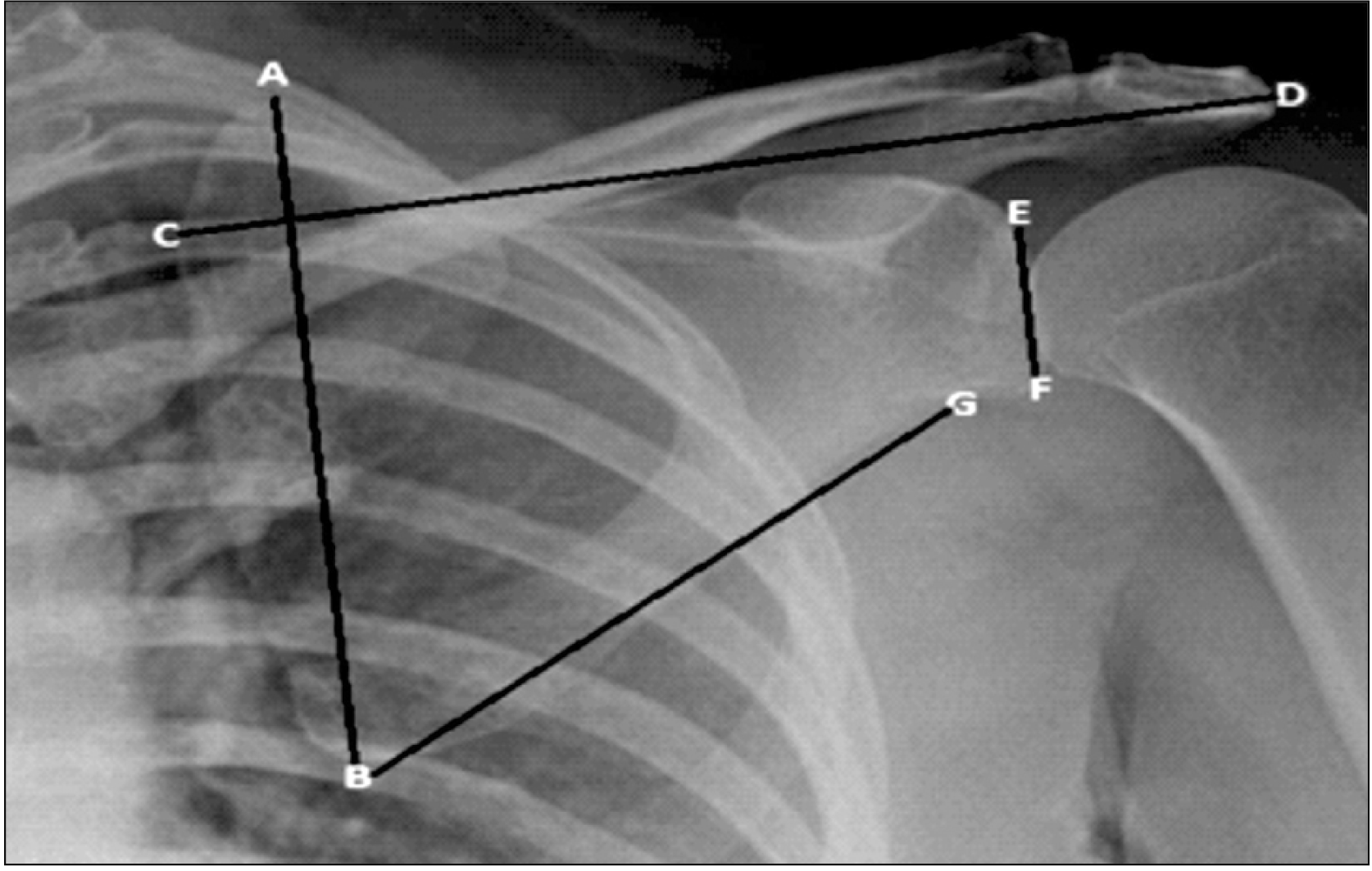Introduction
Materials and Methods
Measurements on the scapulae (Fig. 1)
Maximum length of scapular (MLS): was measured as the distance from the superior angle of the scapular to the inferior angle of the scapular.
Length of scapular spine (LSS): was measured as the distance between the spinal axis at the vertebral border to the most distal point of the acromion process.
Length of supraspinous line (LSL): was measured as the distance between the tip of the superior angle and the spinal axis on the vertebral border.
Length of infraspinous line (LIL): was measured as the distance between the tip of the inferior angle and the spinal axis on the vertebral border.
Acromio-coracoid distance (ACD): was measured as the distance between the most dorsal point on the acromion and the most lateral tip on the coracoid process.
Maximum length of acromion process (MLA): was measured as the distance between the most superior point and the most inferior point on the acromion.
Maximum length of coracoid process (MLC): was measured as the distance between the most lateral tip of the coracoid and the base of the most medial point of the coracoid, often just above the scapular notch.
Maximum length of glenoid fossa (MLG): was measured as the distance between the superior border and the inferior border of the glenoid fossa.
Maximum breadth of glenoid fossa (MBG): was measured as the distance between the ventral border and the dorsal border of the glenoid fossa, usually across the midpoint of the glenoid fossa.
Length of axial border (LAB): was measured as the distance between the most inferior point of the glenoid fossa and the tip of the inferior angle [8, 21, 22].
 | Fig. 1Diagram of the scapula. ACD, acromio-coracoid distance; LAB, length of axial border; LIL, length of infraspinous line; LSL, length of supraspinous line; LSS, length of scapular spine; MLA, maximum length of acromion process; MLC, maximum length of coracoid process; MLS, maximum length of scapular. |
Measurements on the radiograph of scapular (Fig. 2)
MLS: was measured as the distance from the superior angle of the scapular to the inferior angle of the scapular.
LSS: was measured as the distance between the spinal axis at the vertebral border to the most distal point of the acromion process.
MLG: was measured as the distance between the superior border and the inferior border of the glenoid fossa.
LAB: was measured as the distance between the most inferior point of the glenoid fossa and the tip of the inferior angle.
Statistical analysis
Ethical approval
Results
Table 1
S/N, serial number; MLS, maximum length of scapular; LSS, length of scapular spine; LSL, length of supraspinous line; LIL, length of infraspinous line; ACD, acromio-coracoid distance; MLA, maximum length of acromion process; MLC, maximum length of coracoid process; MLG, maximum length of glenoid fossa; MBG, maximum breadth of glenoid fossa; LAB, length of axial border; TEM, technical error of measurement; R, coefficient of reliability; [b], bones; [r], radiograph.
Table 2
S/N, serial number; SD, standard deviation; Unit, cm MLS, maximum length of scapular; LSS, length of scapular spine; LSL, length of supraspinous line; LIL, length of infraspinous line; ACD, acromio-coracoid distance; MLA, maximum length of acromion process; MLC, maximum length of coracoid process; MLG, maximum length of glenoid fossa; MBG, maximum breadth of glenoid fossa; LAB, length of axial border.
Table 3
| S/N | Variable | Right (n=300) | Left (n=300) | Combined (n=600) | |||||||||||
|---|---|---|---|---|---|---|---|---|---|---|---|---|---|---|---|
|
|
|
|
|||||||||||||
| C | SE | M | P-value | C | SE | M | P-value | C | SE | M | P-value | ||||
| 1 | LSS | 7.47 | 0.08 | 0.59 | 0.000* | 5.45 | 0.06 | 0.73 | 0.000* | 6.82 | 0.05 | 0.63 | 0.000* | ||
| 2 | LSL | 12.64 | 0.05 | 0.63 | 0.000* | 12.56 | 0.04 | 0.68 | 0.000* | 12.64 | 0.03 | 0.65 | 0.000* | ||
| 3 | LIL | 6.12 | 0.05 | 1.02 | 0.000* | 6.47 | 0.05 | 0.98 | 0.000* | 6.31 | 0.04 | 1.00 | 0.000* | ||
| 4 | ACD | 9.92 | 0.05 | 0.94 | 0.000* | 9.03 | 0.04 | 0.83 | 0.000* | 9.73 | 0.03 | 0.75 | 0.000* | ||
| 5 | MLA | 7.04 | 0.02 | 1.99 | 0.000* | 10.05 | 0.02 | 1.23 | 0.000* | 8.57 | 0.02 | 1.61 | 0.000* | ||
| 6 | MLC | 7.78 | 0.03 | 1.67 | 0.000* | 11.24 | 0.04 | 0.86 | 0.000* | 10.02 | 0.02 | 1.15 | 0.000* | ||
| 7 | MLG | 6.46 | 0.02 | 2.49 | 0.000* | 13.34 | 0.02 | 0.43 | 0.021* | 10.60 | 0.01 | 1.24 | 0.000* | ||
| 8 | MBG | 9.21 | 0.02 | 2.39 | 0.000* | 12.16 | 0.02 | 1.06 | 0.000* | 11.19 | 0.01 | 1.49 | 0.000* | ||
| 9 | LAB | 0.66 | 0.06 | 1.13 | 0.000* | 5.79 | 0.06 | 0.71 | 0.000* | 3.37 | 0.04 | 0.91 | 0.000* | ||
S/N, serial number; C, regression constant; SE, standard error; M, coefficient of regression Unit, cm; LSS, length of scapular spine; LSL, length of supraspinous line; LIL, length of infraspinous line; ACD, acromio-coracoid distance; MLA, maximum length of acromion process; MLC, maximum length of coracoid process; MLG, maximum length of glenoid fossa; MBG, maximum breadth of glenoid fossa; LAB, length of axial border. *Significant at P<.005.
Table 4
Table 5
| S/N | Variable | C | SE | M | P-value | C | SE | M | P-value | C | SE | M | P-value |
|---|---|---|---|---|---|---|---|---|---|---|---|---|---|
| Male right (n=153) | Male left (n=153) | Combined (n=306) | |||||||||||
| 1 | LSS | 9.03 | 0.10 | 0.49 | 0.000* | 6.10 | 0.08 | 0.69 | 0.000* | 8.16 | 0.06 | 0.55 | 0.000* |
| 2 | MLG | 7.37 | 0.03 | 2.30 | 0.000* | 14.10 | 0.03 | 0.33 | 0.203 | 10.87 | 0.02 | 1.28 | 0.000* |
| 3 | LAB | 0.97 | 0.08 | 1.12 | 0.000* | 6.47 | 0.07 | 0.68 | 0.000* | 3.71 | 0.05 | 0.90 | 0.000* |
| Female right (n=147) | Female left (n=147) | Combined (n=294) | |||||||||||
| 1 | LSS | 8.08 | 0.12 | 0.52 | 0.000* | 7.25 | 0.09 | 0.57 | 0.000* | 7.84 | 0.07 | 0.53 | 0.000* |
| 2 | MLG | 9.37 | 0.02 | 1.57 | 0.000* | 13.36 | 0.03 | 0.33 | 0.120 | 12.39 | 0.02 | 0.63 | 0.001* |
| 3 | LAB | 2.55 | 0.07 | 0.97 | 0.000* | 7.75 | 0.08 | 0.54 | 0.000* | 5.60 | 0.05 | 0.72 | 0.000* |
Table 6
| S/N | Variable | Minimum (cm) | Maximum (cm) | Mean±SD (cm) | C | SE | M | P-value |
|---|---|---|---|---|---|---|---|---|
| 1 | MLS | 10.80 | 17.60 | 14.93±1.17 | - | - | - | - |
| 2 | LSS | 7.70 | 18.80 | 12.82±1.23 | 7.470 | 0.050 | 0.582 | 0.000* |
| 3 | MLG | 2.70 | 4.60 | 3.44±0.33 | 11.368 | 0.013 | 0.013 | 0.000* |
| 4 | LAB | 9.20 | 15.20 | 12.68±0.93 | 3.998 | 0.038 | 0.862 | 0.000* |
Discussion
Table 7
| References | Population | Mean length (cm) | Best parameter |
|---|---|---|---|
| Campobasso et al. (1998) [22] | Italian | Male=14.62 | Males - MB MBG |
| Female=12.97 | Females - MLC MBG | ||
| Kui et al. (2016) [8] | Chines | Male=16.73 | LAM |
| Female=15.77 | |||
| Igwe and Akpuaka (2013) [23] | South-east Nigeria | Male=14.00 | Nile |
| Female=13.50 | |||
| Current study | Nigerians | Bones | |
| Right=14.89 | MLG, LAB | ||
| Left=14.83 | LIL | ||
| Combined=14.86 | LIL, LAB | ||
| Radiographs | |||
| Male right=15.33 | MLG, LAB | ||
| Left=15.26 | LSS | ||
| Combined= 15.29 | MLG, LAB | ||
| Female right=14.57 | LAB | ||
| Left=14.51 | LSS | ||
| Combined=14.54 | LAB | ||
| All radiographs=14.92 | LAB |




 PDF
PDF Citation
Citation Print
Print




 XML Download
XML Download